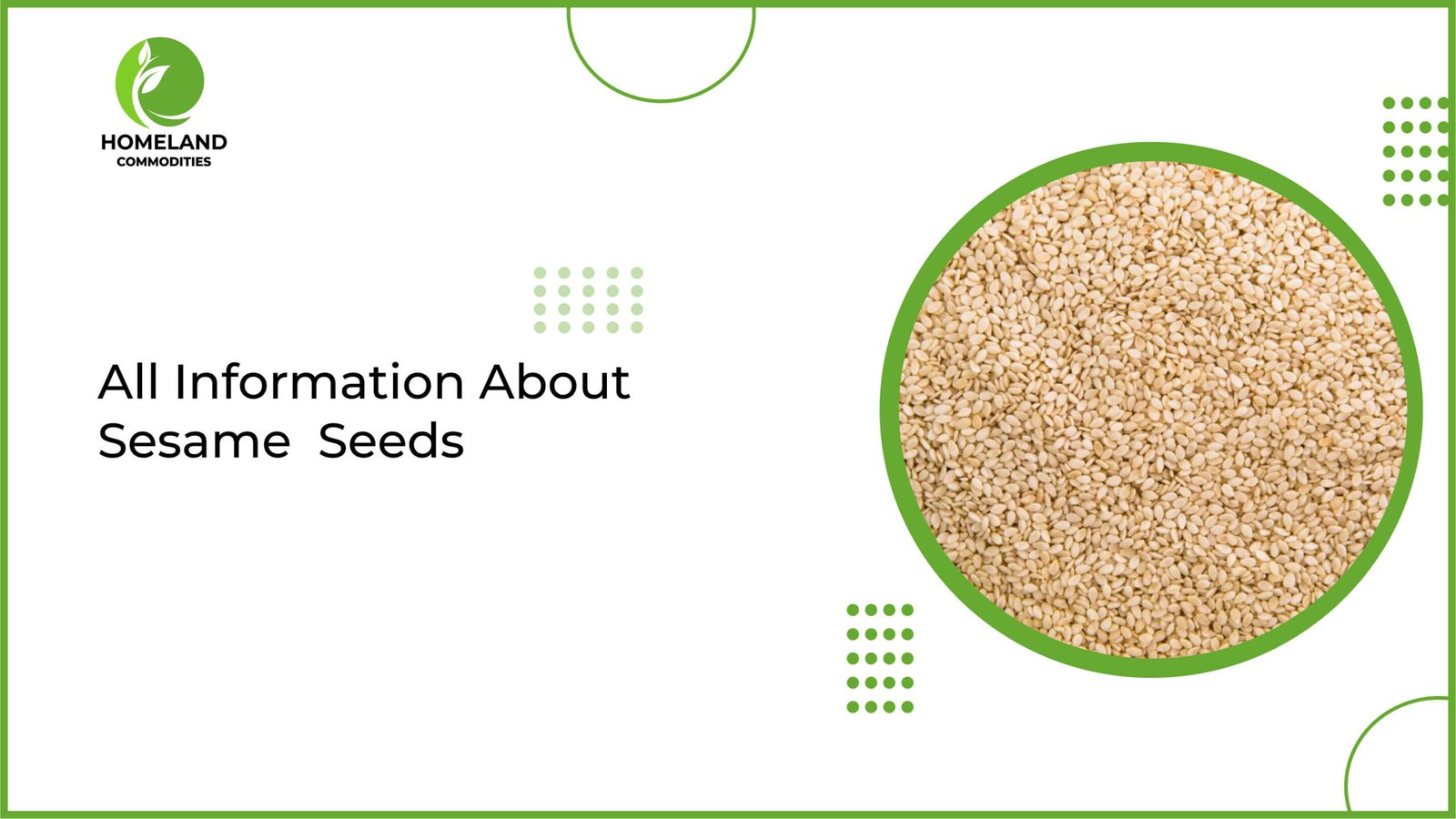Introduction
Sesame seeds, obtained from the Sesamum indicum plant, are one of humanity’s earliest cultivated seeds, with a history spanning over 3,000 years. These small seeds, abundant in oil and known for their rich, nutty taste and health advantages, have been highly valued in diverse cultures. Originating in Africa and India, sesame seeds rapidly disseminated throughout Asia, the Middle East, and beyond, owing to their adaptability in cuisine, medicinal attributes, and oil production.
Types of Sesame Seed
The types of sesame seed are
White sesame seed
The most common type, white sesame seeds are distinguished by their smooth, creamy hue. They boast a gentle, subtly sweet taste compared to other types, rendering them adaptable for a wide array of culinary applications, whether in desserts or savory recipes. White sesame seeds are commonly employed in baking, as a garnish for breads and pastries, or as an embellishment in salads and stir-fried dishes.
Black Sesame Seeds
Black sesame seeds are smaller and boast a richer, nuttier taste compared to their white counterparts. They are prevalent in Asian cuisine, especially in desserts and sweets. Beyond their culinary uses, black sesame seeds are esteemed in traditional medicine for potential health benefits, such as enhancing hair and skin health.
Brown Sesame Seeds
Brown sesame seeds offer a middle ground in flavor intensity and nutritional content between white and black varieties. Although less common, they are still utilized in various culinary applications, particularly in bread-making and as garnishes.
Nutritional Profile
Macronutrients
Sesame seeds are nutritionally dense and packed with essential macronutrients:
- Protein: Comprising about 20% of their weight, they are a valuable protein source for vegetarians and vegans.
- Carbohydrates: Low in carbohydrates, making them suitable for low-carb diets.
- Fats: Rich in healthy fats, predominantly monounsaturated and polyunsaturated fats, which benefit heart health.
Micronutrients
- Vitamins: Sesame seeds are rich in B vitamins, including thiamine (B1), riboflavin (B2), niacin (B3), and folate (B9), all crucial for energy metabolism and overall health.
- Minerals: High in calcium, iron, magnesium, phosphorus, and zinc, essential for bone health, blood clotting, muscle function, and immune support.
- Antioxidants: Contain potent antioxidants like sesamin and sesamolin, which protect cells from free radical damage and oxidative stress.
Health Benefits
Heart Health
The combination of healthy fats, fiber, and antioxidants in sesame seeds supports cardiovascular health by:
- Lowering Cholesterol: Phytosterols in sesame seeds help lower cholesterol levels, reducing heart disease risk.
- Regulating Blood Pressure: Magnesium in sesame seeds relaxes blood vessels, aiding in lowering blood pressure.
Bone Health
Rich in calcium, magnesium, and phosphorus, sesame seeds help maintain strong bones and prevent osteoporosis, contributing to improved bone density and skeletal health.
Digestive Health
The fiber content in sesame seeds promotes digestive health by:
- Preventing Constipation: Dietary fiber adds bulk to stool, aiding regular bowel movements.
- Supporting Gut Health: Prebiotics in sesame seeds nourish beneficial gut bacteria, fostering a healthy gut microbiome.
Skin and Hair Benefits
Sesame seeds and oil are valued for their nourishing properties:
- Moisturizing Skin: Sesame oil, rich in antioxidants and vitamins E and B complex, moisturizes and protects skin.
- Strengthening Hair: Nutrients like zinc and vitamin B6 in sesame seeds support hair growth and strengthen hair follicles, reducing hair loss.
Anti-inflammatory Properties
Compounds like sesamin and sesamol in sesame seeds exhibit anti-inflammatory properties, potentially reducing inflammation and benefiting conditions like arthritis and inflammatory bowel diseases.
Culinary Uses
In Cooking
Sesame seeds are versatile, adding a nutty flavor and texture to various dishes:
- Stir-fries: Commonly used as a garnish for stir-fried vegetables and meats.
- Salads: Sprinkled on salads for added crunch and flavor.
- Sauces: Key ingredient in sauces like tahini and gomashio, adding richness and depth.
In Baking
Used to enhance the flavor and texture of baked goods:
- Breads and Bagels: Often sprinkled on top before baking, adding a decorative crust and nutty flavor.
- Cookies and Pastries: Incorporated into doughs and crusts for extra flavor and nutrition.
As Garnish
Toasted sesame seeds are commonly used as a garnish in various cuisines:
- Asian Cuisine: Sprinkled over sushi, noodles, and rice dishes for a nutty flavor and visual appeal.
- Middle Eastern Cuisine: Essential in dishes like hummus and falafel, used both in mixtures and as a topping.
Sesame Oil
Sesame oil, extracted from sesame seeds, is widely used in cooking and cosmetics:
- Cooking: Suitable for stir-frying, sautéing, and deep-frying due to its high smoke point.
- Salad Dressings: Adds a distinctive nutty flavor to dressings and marinades.
- Cosmetics: Used in skincare products for its moisturizing and antioxidant properties.
Tahini
Tahini, a paste made from ground sesame seeds, is a staple in Middle Eastern cuisine:
- Hummus: A key ingredient, adding creaminess and richness.
- Dressings and Sauces: Used in salad dressings, sauces for grilled meats, and dips for vegetables.
- Desserts: Included in desserts like halva, a sweet confection.
Growing and Harvesting
Cultivation
Sesame plants thrive in warm climates with well-drained soil:
- Climate: Grown in tropical and subtropical regions, including Asia, Africa, and Central America.
- Soil Requirements: Prefer sandy, loamy soil that drains well to prevent waterlogging.
Sesame seeds are harvested when the seed pods mature and turn brown:
Harvesting
- Timing: Typically harvested 90-120 days after planting, depending on variety and growing conditions.
- Method: Harvested by hand or with machinery, depending on cultivation scale.
Processing
Post-harvest, sesame seeds undergo several processing steps:
- Cleaning: Seeds are cleaned to remove dirt, debris, and plant matter.
- Hulling: Outer husk is removed to reveal the edible seed.
- Roasting (Optional): Seeds may be roasted to enhance flavor before packaging.
Storage and Shelf Life
Proper Storage Techniques
To maintain freshness and prevent rancidity, sesame seeds should be stored properly:
- Airtight Containers: Store in airtight containers in a cool, dry place away from sunlight.
- Refrigeration: Store in the refrigerator or freezer for longer shelf life, especially in hot and humid climates.
Shelf Life of Different Forms
- Raw Seeds: Unopened raw seeds can last up to 2 years if stored properly.
- Roasted Seeds: Have a shorter shelf life, typically lasting 6-12 months.
- Sesame Oil: Unopened oil can be stored for up to 1 year; once opened, use within a few months for optimal quality.
Potential Allergies and Side Effects
Common Allergies
Some individuals may be allergic to sesame seeds, experiencing symptoms ranging from mild skin reactions to severe anaphylaxis:
- Skin Reactions: Itching, redness, or swelling around the mouth or throat.
- Digestive Issues: Nausea, vomiting, or diarrhea shortly after consumption.
- Respiratory Symptoms: Difficulty breathing, wheezing, or throat tightness (anaphylaxis).
Possible Side Effects
Consuming sesame seeds in moderation is generally safe, but excessive intake may lead to:
- Digestive Discomfort: High fiber content can cause bloating, gas, or diarrhea if consumed in large quantities.
- Caloric Intake: Being calorie-dense, overconsumption can contribute to weight gain.
Conclusion
Sesame seeds are more than just a flavorful addition to dishes; they are a nutritional powerhouse with numerous health benefits. From promoting heart and bone health to nourishing skin and hair, sesame seeds offer a range of culinary and medicinal uses. Whether sprinkled on salads, incorporated into baked goods, or used in sesame oil, these seeds are a versatile and valuable addition to any diet.


